
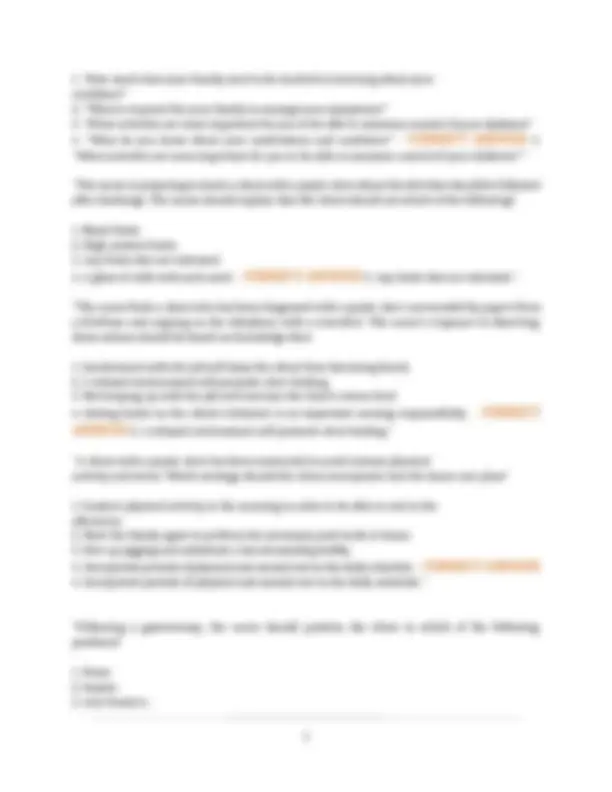
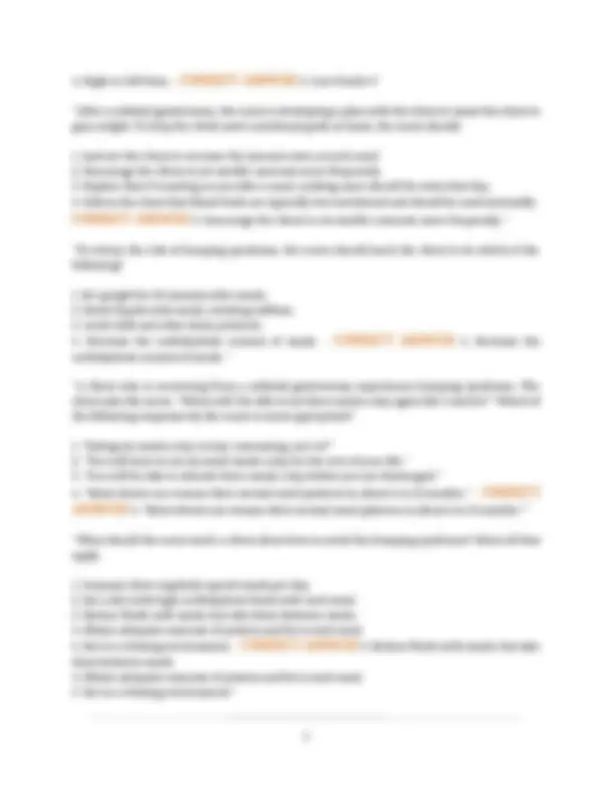

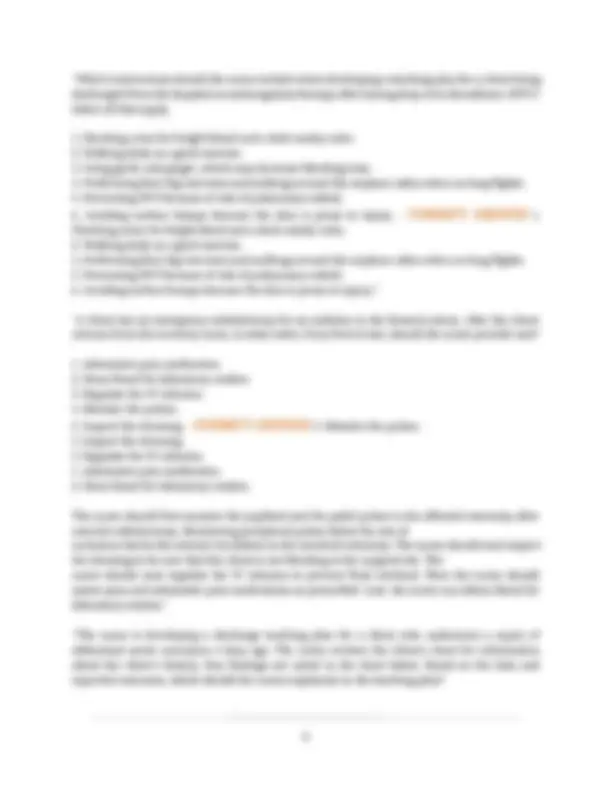
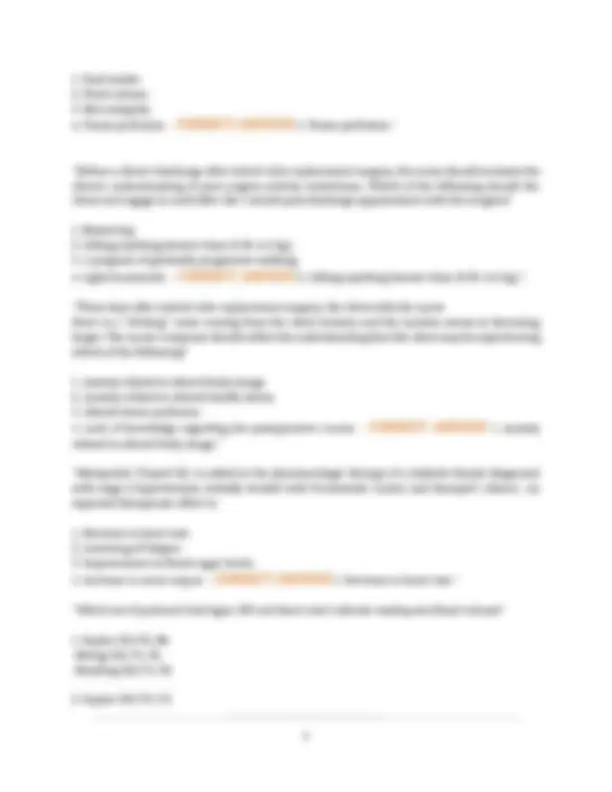
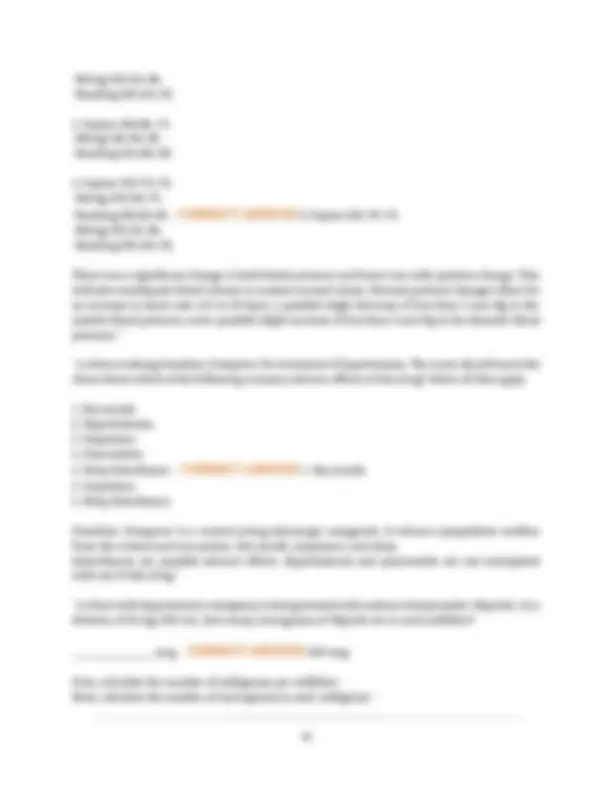
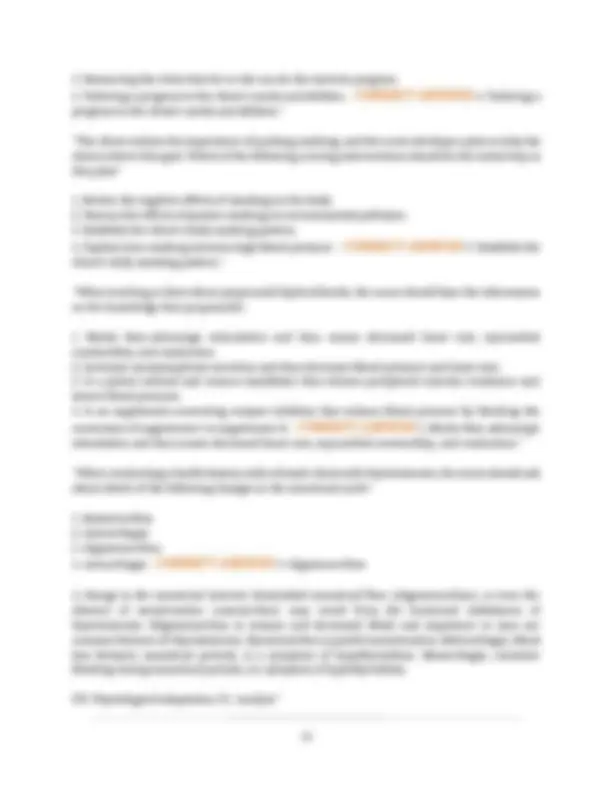
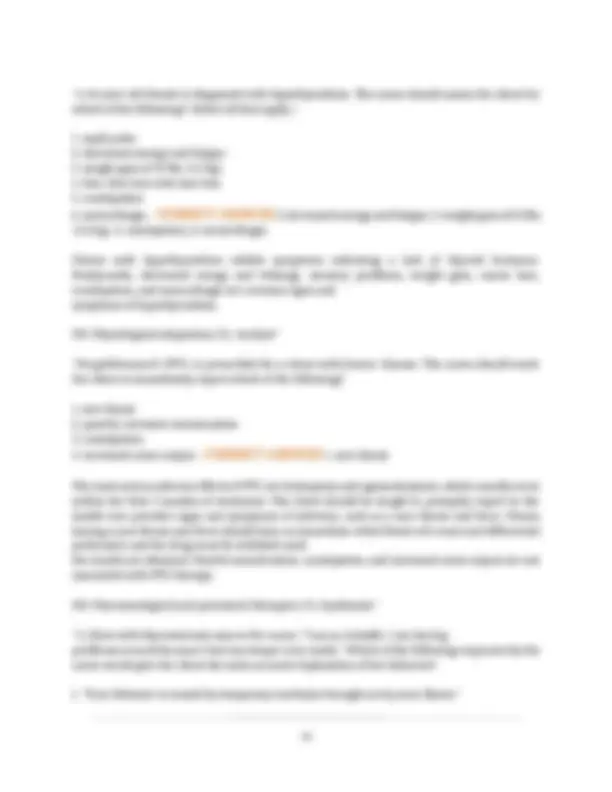
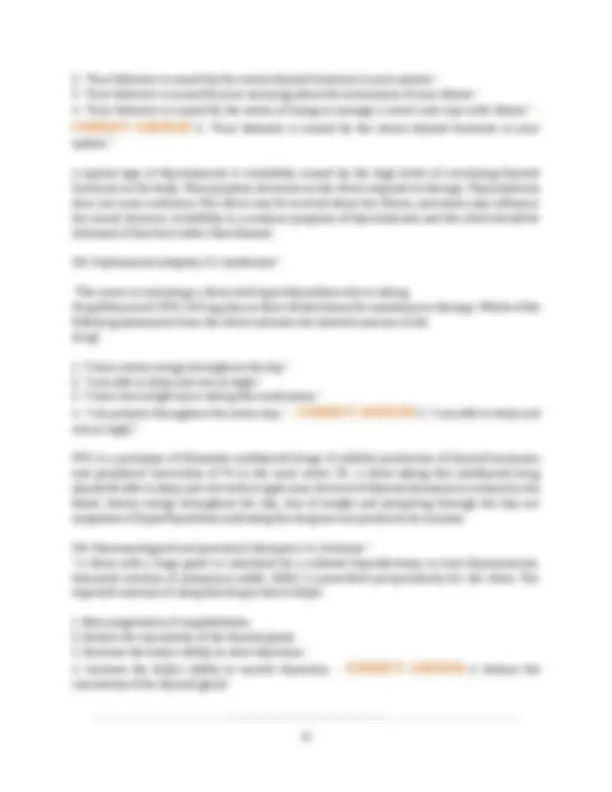
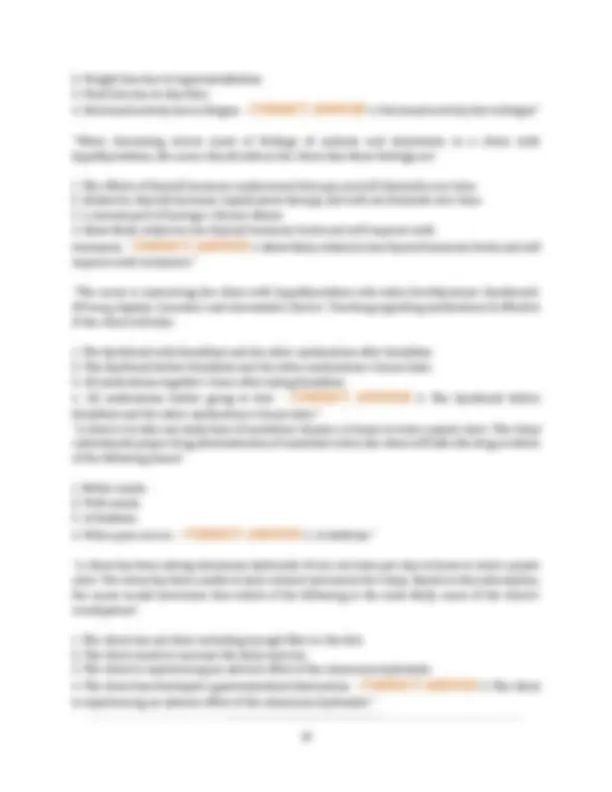
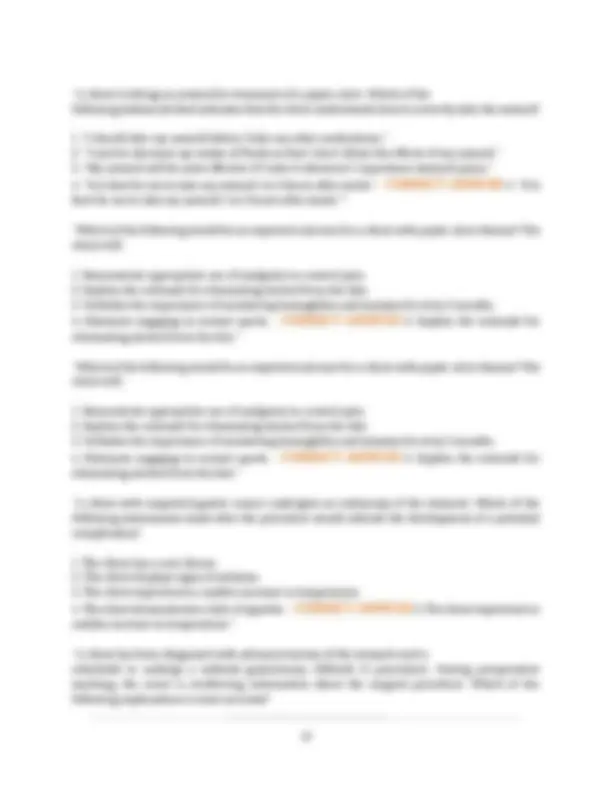
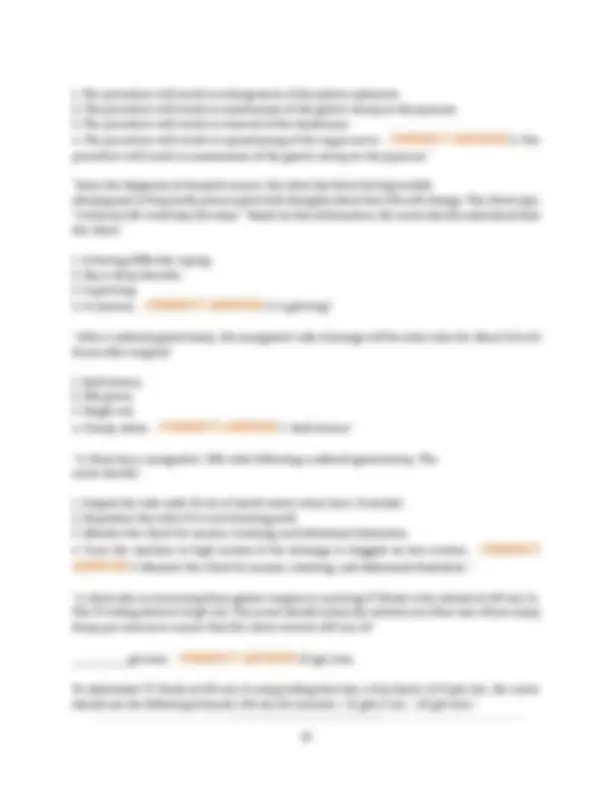
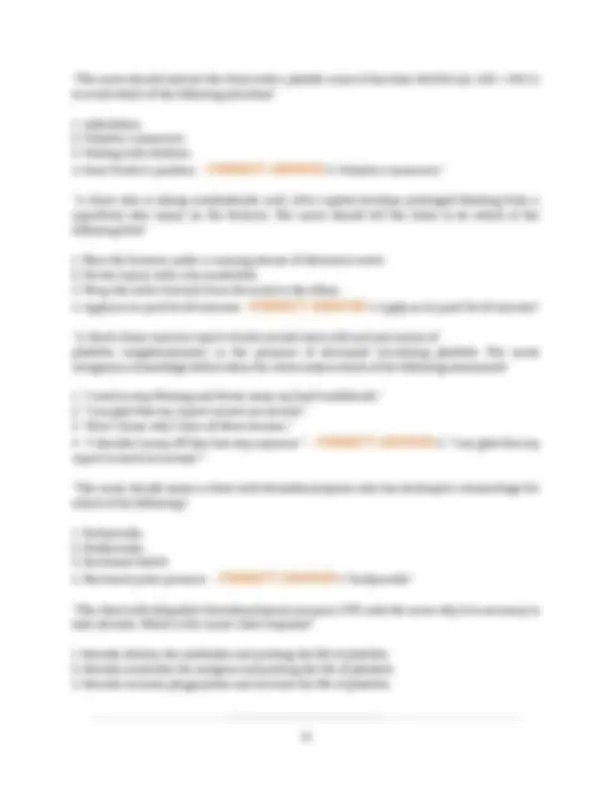
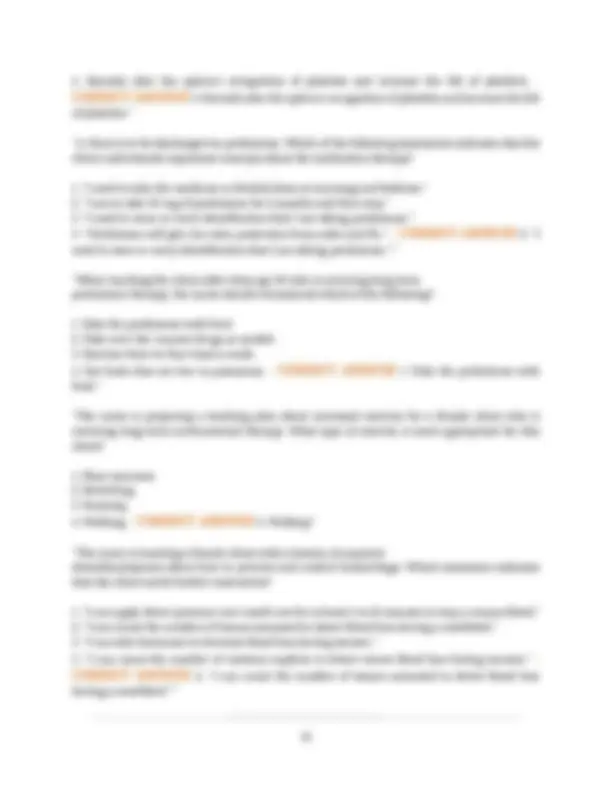
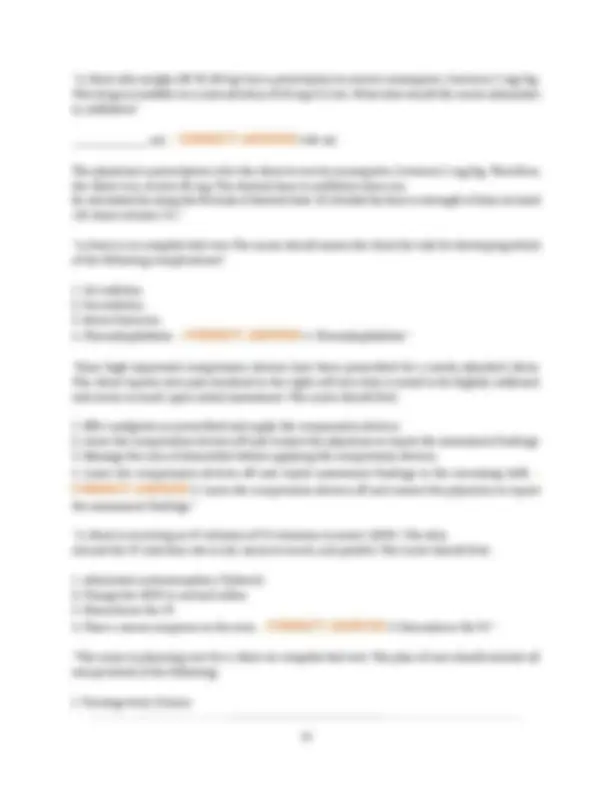
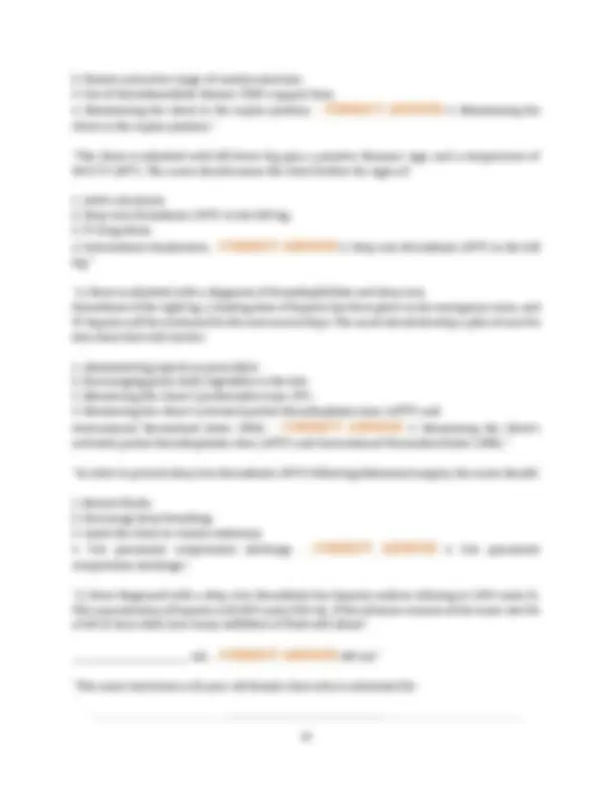
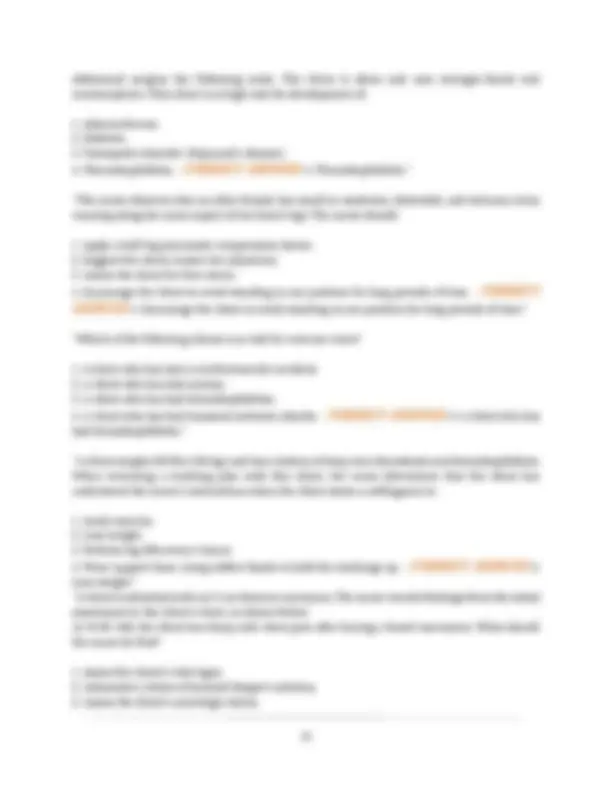
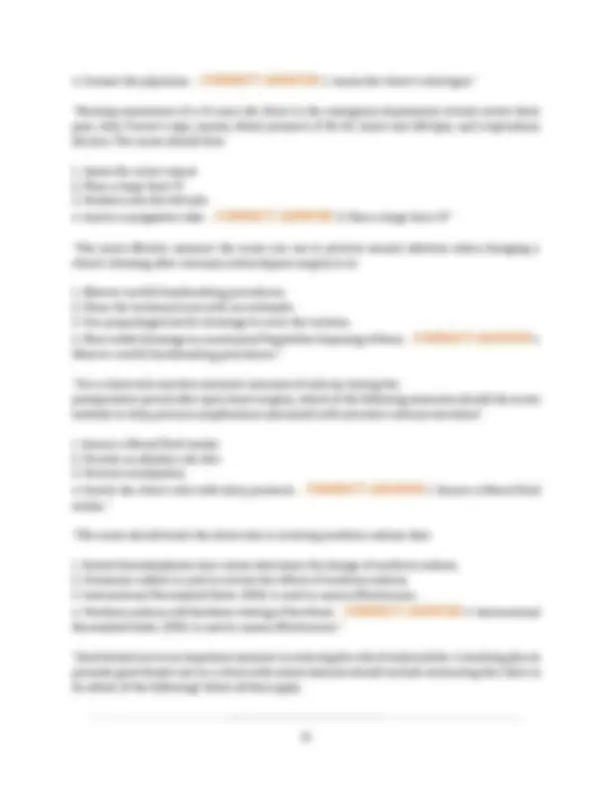
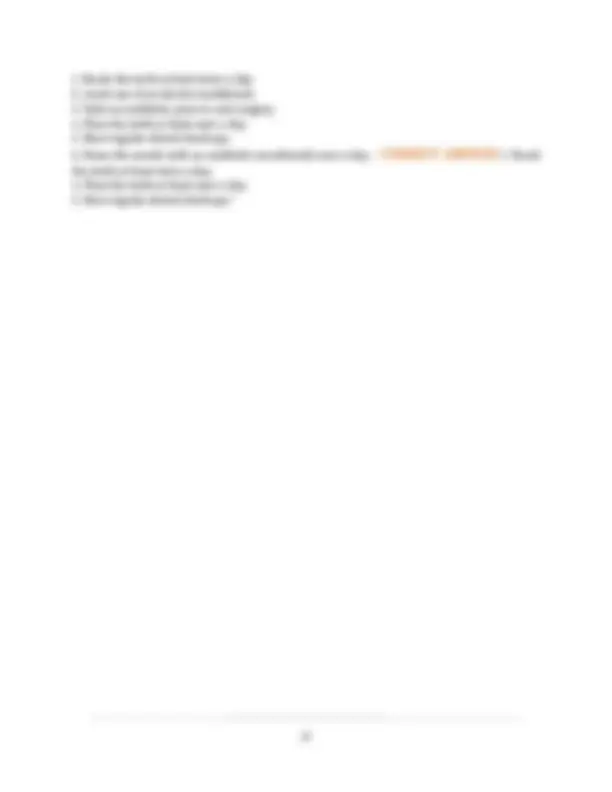


Study with the several resources on Docsity

Earn points by helping other students or get them with a premium plan


Prepare for your exams
Study with the several resources on Docsity

Earn points to download
Earn points by helping other students or get them with a premium plan
Community
Ask the community for help and clear up your study doubts
Discover the best universities in your country according to Docsity users
Free resources
Download our free guides on studying techniques, anxiety management strategies, and thesis advice from Docsity tutors
NURSING MED-SURG II HESI EXAM VERIFIED ACTUAL QUESTIONS AND ANSWERS FOR GUARANTEED PASS
Typology: Exams
1 / 27

This page cannot be seen from the preview
Don't miss anything!




















“The nurse is completing a health assessment of a 42-year-old female with suspected Graves' Disease. The nurse should assess this client for:
Graves' disease, the most common type of thyrotoxicosis, is a state of hypermetabolism. The increased metabolic rate generates heat and produces tachycardia and fine muscle tremors. Anorexia is associated with hypothyroidism. Loss of weight, despite a good appetite and adequate caloric intake, is a common feature of hyperthyroidism. Cold skin is associated with hypothyroidism. CN: Physiological adaptation; CL: Analyze" "The nurse should teach the client with Graves' disease to prevent corneal irritation from mild exophthalmos by:
colored glasses. Treatment of mild ophthalmopathy that may accompany thyrotoxicosis includes measures such as wearing sunglasses to protect the eyes from corneal irritation. Treatment of ophthalmopathy should be performed in consultation with an ophthalmologist. Massaging the eyes will not help to protect the cornea. An ophthalmic anesthetic is used to examine and possibly treat a painful eye, not protect the cornea. Covering the eyes with moist gauze pads is not a satisfactory nursing measure to protect the eyes of a client with exophthalmos because treatment is not focused on moisture to the eye but rather on protecting the cornea and optic nerve. In exophthalmos, the retrobulbar connective tissues and extraocular muscle volume are expanded because of fluid retention. The pressure is also increased. CN: Reduction of risk potential; CL: Synthesize"
"A client with Graves' disease is treated with radioactive iodine (RAI) in the form of sodium iodide 131I. Which of the following statements by the nurse will explain to the client how the drug works?
longer produced." Sodium iodide 131I destroys the thyroid follicular cells, and thyroid hormones are no longer produced. RAI is commonly recommended for clients with Graves' disease, especially the elderly. The treatment results in a "medical thyroidectomy." RAI is given in lieu of surgery, not before surgery. RAI does not reduce uptake of thyroxine. The outcome of giving RAI is the destruction of the thyroid follicular cells. It is possible to slow the production of thyroid hormones with RAI. CN: Pharmacological and parenteral therapies; CL: Synthesize" "After treatment with radioactive iodine (RAI) in the form of sodium iodide 131I, the nurse teaches the client to:
The client needs to be educated about the need for lifelong thyroid hormone replacement. Permanent hypothyroidism is the major complication of RAI 131I treatment. Lifelong medical follow-up and thyroid replacement are warranted. The client needs to monitor for signs and symptoms of hypothyroidism, not hyperthyroidism. Resting for 1 week is not necessary. Hypertension and tachycardia are signs of hyperthyroidism, not hypothyroidism. CN: Pharmacological and parenteral therapies; CL: Synthesize" "The nurse is teaching a diabetic client using an empowerment approach. The nurse should initiate teaching by asking which of the following?
"After a subtotal gastrectomy, the nurse is developing a plan with the client to assist the client to gain weight. To help the client meet nutritional goals at home, the nurse should:
"To reduce the risk of dumping syndrome, the nurse should teach the client to do which of the following?
carbohydrate content of meals." "A client who is recovering from a subtotal gastrectomy experiences dumping syndrome. The client asks the nurse, "When will I be able to eat three meals a day again like I used to?" Which of the following responses by the nurse is most appropriate?
"What should the nurse teach a client about how to avoid the dumping syndrome? Select all that apply.
them between meals.
"After surgery for gastric cancer, a client is scheduled to undergo radiation therapy. It will be most important for the nurse to include information about which of the following in the client's teaching plan?
"The nurse should instruct the client with a platelet count of 31,000/ μL (31 × 109/L) to:
trauma when walking." "A client with a history of systemic lupus erythematosus was admitted with a severe viral respiratory tract infection and diffuse petechiae. Based on these data, it is most important that the nurse further evaluate the client's recent:
menstrual flow." "When a client with thrombocytopenia has a severe headache, the nurse interprets that this may indicate which of the following?
"The nurse evaluates that the client correctly understands how to report signs and symptoms of bleeding when the client makes which of the following statements?
"A client is scheduled for an elective splenectomy. Immediately before the client goes to surgery, the nurse should determine that the client has:
"When receiving a client from the post anesthesia care unit after a splenectomy, which should the nurse assess next after obtaining vital signs?
"The client's family asks why the client who had a splenectomy has a nasogastric (NG) tube. An NG tube is used to:
abdominal distention." "A client is admitted with an acute onset of shortness of breath. A diagnosis of pulmonary embolism is made. One common cause of pulmonary embolism is:
"A client with a cerebral embolus is receiving streptokinase. The nurse should evaluate the client for which of the following expected outcomes of this drug therapy?
"Which instructions should the nurse include when developing a teaching plan for a client being discharged from the hospital on anticoagulant therapy after having deep vein thrombosis (DVT)? Select all that apply.
Checking urine for bright blood and a dark smoky color.
Sitting 102/64, 86. Standing 100/60, 92.
Sitting 102/64, 86. Standing 100/60, 92. There was a significant change in both blood pressure and heart rate with position change. This indicates inadequate blood volume to sustain normal values. Normal postural changes allow for an increase in heart rate of 5 to 20 bpm, a possible slight decrease of less than 5 mm Hg in the systolic blood pressure, and a possible slight increase of less than 5 mm Hg in the diastolic blood pressure." "A client is taking clonidine (Catapres) for treatment of hypertension. The nurse should teach the client about which of the following common adverse effects of this drug? Select all that apply.
First, calculate the number of milligrams per milliliter: Next, calculate the number of micrograms in each milligram:"
"The nurse is discussing medications with a client with hypertension who has a prescription for furosemide (Lasix) daily. The client needs further education when the client states which of the following?
"In teaching the client with hypertension to avoid orthostatic hypotension, the nurse should emphasize which of the following instructions? Select all that apply.
sudden discontinuation of the drug." "The nurse teaches a client who has recently been diagnosed with hypertension about following a low-calorie, low-fat, low-sodium diet. Which of the following menu selections would best meet the client's needs?
an apple, and a slice of white bread." "A client who has diabetes is taking metoprolol (Lopressor) for hypertension. Which of the following information should the nurse include in the teaching plan? Select all that apply
program to the client's needs and abilities." "The client realizes the importance of quitting smoking, and the nurse develops a plan to help the client achieve this goal. Which of the following nursing interventions should be the initial step in this plan?
client's daily smoking pattern." "When teaching a client about propranolol hydrochloride, the nurse should base the information on the knowledge that propranolol:
stimulation and thus causes decreased heart rate, myocardial contractility, and conduction." "When conducting a health history with a female client with thyrotoxicosis, the nurse should ask about which of the following changes in the menstrual cycle?
A change in the menstrual interval, diminished menstrual flow (oligomenorrhea), or even the absence of menstruation (amenorrhea) may result from the hormonal imbalances of thyrotoxicosis. Oligomenorrhea in women and decreased libido and impotence in men are common features of thyrotoxicosis. Dysmenorrhea is painful menstruation. Metrorrhagia, blood loss between menstrual periods, is a symptom of hypothyroidism. Menorrhagia, excessive bleeding during menstrual periods, is a symptom of hypothyroidism. CN: Physiological adaptation; CL: Analyze"
"A 34-year-old female is diagnosed with hypothyroidism. The nurse should assess the client for which of the following? (Select all that apply.)
(4.5 kg), 5. constipation, 6. menorrhagia Clients with hypothyroidism exhibit symptoms indicating a lack of thyroid hormone. Bradycardia, decreased energy and lethargy, memory problems, weight gain, coarse hair, constipation, and menorrhagia are common signs and symptoms of hypothyroidism. CN: Physiological adaptation; CL: Analyze" "Propylthiouracil (PTU) is prescribed for a client with Graves' disease. The nurse should teach the client to immediately report which of the following?
The most serious adverse effects of PTU are leukopenia and agranulocytosis, which usually occur within the first 3 months of treatment. The client should be taught to promptly report to the health care provider signs and symptoms of infection, such as a sore throat and fever. Clients having a sore throat and fever should have an immediate white blood cell count and differential performed, and the drug must be withheld until the results are obtained. Painful menstruation, constipation, and increased urine output are not associated with PTU therapy. CN: Pharmacological and parenteral therapies; CL: Synthesize" "A client with thyrotoxicosis says to the nurse, "I am so irritable. I am having problems at work because I lose my temper very easily." Which of the following responses by the nurse would give the client the most accurate explanation of her behavior?
SSKI is frequently administered before a thyroidectomy because it helps decrease the vascularity of the thyroid gland. A highly vascular thyroid gland is very friable, a condition that presents a hazard during surgery. Preparation of the client for surgery includes depleting the gland of thyroid hormone and decreasing vascularity. SSKI does not decrease the progression of exophthalmos, and it does not decrease the body's ability to store thyroxine or increase the body's ability to excrete thyroxine. CN: Pharmacological and parenteral therapies; CL: Apply" "The nurse is administering a saturated solution of potassium iodide (SSKI). The nurse should:
solution with water, milk, or fruit juice and have the client drink it with a straw. SSKI should be diluted well in milk, water, juice, or a carbonated beverage before administration to help disguise the strong, bitter taste. Also, this drug is irritating to mucosa if taken undiluted. The client should sip the diluted preparation through a drinking straw to help prevent staining of the teeth. Pouring the solution over ice chips will not sufficiently dilute the SSKI or cover the taste. Antacids are not used to dilute or cover the taste of SSKI. Mixing in a puree would put the SSKI in contact with the teeth. CN: Pharmacological and parenteral therapies; CL: Apply" "Following a subtotal thyroidectomy, the nurse asks the client to speak immediately upon regaining consciousness. The nurse does this to monitor for signs of which of the following?
Laryngeal nerve damage is a potential complication of thyroid surgery because of the proximity of the thyroid gland to the recurrent laryngeal nerve. Asking the client to speak helps assess for signs of laryngeal nerve damage. Persistent or worsening hoarseness and weak voice are signs of laryngeal nerve damage and should be reported to the physician immediately. Internal hemorrhage is detected by changes in vital signs. The client's level of consciousness can be partially assessed by asking her to speak, but that
is not the primary reason for doing so in this situation. Upper airway obstruction is detected by color and respiratory rate and pattern. CN: Reduction of risk potential; CL: Analyze" "A client who has undergone a subtotal thyroidectomy is subject to complications in the first 48 hours after surgery. The nurse should obtain and keep at the bedside equipment to:
"One day following a subtotal thyroidectomy, a client begins to have tingling in the fingers and toes. The nurse should first:
"Which of the following medications should be available to provide emergency treatment if a client develops tetany after a subtotal thyroidectomy?
"A 60-year-old female is diagnosed with hypothyroidism. The nurse should assess the client for which of the following?
"The nurse should assess a client with hypothyroidism for which of the following?
"A client is taking an antacid for treatment of a peptic ulcer. Which of the following statements best indicates that the client understands how to correctly take the antacid?
best for me to take my antacid 1 to 3 hours after meals."" "Which of the following would be an expected outcome for a client with peptic ulcer disease? The client will:
eliminating alcohol from the diet." "Which of the following would be an expected outcome for a client with peptic ulcer disease? The client will:
eliminating alcohol from the diet." "A client with suspected gastric cancer undergoes an endoscopy of the stomach. Which of the following assessments made after the procedure would indicate the development of a potential complication?
sudden increase in temperature." "A client has been diagnosed with adenocarcinoma of the stomach and is scheduled to undergo a subtotal gastrectomy (Billroth II procedure). During preoperative teaching, the nurse is reinforcing information about the surgical procedure. Which of the following explanations is most accurate?
procedure will result in anastomosis of the gastric stump to the jejunum." "Since the diagnosis of stomach cancer, the client has been having trouble sleeping and is frequently preoccupied with thoughts about how life will change. The client says, "I wish my life could stay the same." Based on this information, the nurse should understand that the client:
"After a subtotal gastrectomy, the nasogastric tube drainage will be what color for about 12 to 24 hours after surgery?
"A client has a nasogastric (NG) tube following a subtotal gastrectomy. The nurse should:
"A client who is recovering from gastric surgery is receiving IV fluids to be infused at 100 mL/h. The IV tubing delivers 15 gtt/mL. The nurse should infuse the solution at a flow rate of how many drops per minute to ensure that the client receives 100 mL/h?
To administer IV fluids at 100 mL/h using tubing that has a drip factor of 15 gtt/mL, the nurse should use the following formula: 100 mL/60 minutes × 15 gtts/1 mL = 25 gtt/min."